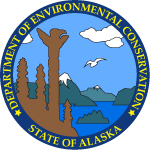| Action Date |
Action |
Description |
DEC Staff |
| 1/7/1994 |
Update or Other Action |
ADEC sent the Corps of Engineers a letter requesting that it undertake a removal action to cleanup the tar ponds. |
John Halverson |
| 7/5/1994 |
Update or Other Action |
ADEC sent the Corps of Engineers another letter requesting it undertake a removal action to clean up the tar ponds. |
John Halverson |
| 9/5/1994 |
Update or Other Action |
ADEC sent the Corps of Engineers a letter informing them someone had fallen into one of the tar ponds. Requested the Corps undertake a removal action to address the hazard. Requested a response within fifteen days. |
John Halverson |
| 10/6/1994 |
Update or Other Action |
Corps responds to ADEC stating that it is premature to identify the Department of Defense as a responsible party for this matter. |
John Halverson |
| 12/29/1994 |
Update or Other Action |
Alaska District Corps of Engineers sent ADEC a letter stating it would take the lead on conducting a removal action on the tar ponds. |
John Halverson |
| 1/17/1995 |
Update or Other Action |
ADEC received a letter from Ounalashka Corp stating that it has fenced off the tar ponds to limit access. |
John Halverson |
| 5/1/1995 |
Update or Other Action |
ADEC met with the Corps of Engineers, Ounalashka Corp, Chevron and Delta Western to discuss cost sharing on cleaning up the tar ponds; Corps, Chevron and Delta Western agreed to continue developing a cost sharing agreement. |
John Halverson |
| 6/20/1995 |
Update or Other Action |
ADEC sent another letter to Corps, Chevron, Delta Western and OC requesting a removal action be implemented in 1995. See the file for details significant correspondence regarding responsibilities, cost sharing, contracting, etc. |
John Halverson |
| 5/1/1996 |
Site Ranked Using the AHRM |
Ranked by Shannon and Wilson. |
S&W |
| 2/15/1997 |
Update or Other Action |
Chevron and Delta Western agreed to cleanup ponds C and D; Corps of Engineers agreed to address pond B. |
John Halverson |
| 10/27/1997 |
Cleanup Plan Approved |
ADEC concurs with Corps plan for cleanup at Tar Pond B. |
John Halverson |
| 3/9/1999 |
Update or Other Action |
(verify date...) ADEC received the cleanup report from the Corps of Engineers documenting the removal and treatment of soil, oil and water from tar pond B. Confirmation sampling indicates soil cleanup levels were achieved with the exception of one area where further excavation was not feasible due to bedrock. Anticipate this site will be address in a future decision document addressing areas within Rocky Point. |
John Halverson |
| 8/2/1999 |
Update or Other Action |
ADEC received the cleanup report from Chevron, prepared by RRM Consultants. Numerous questions remain regarding the cleanup and the fact the ~400 cubic yards of contaminated soil were left stockpiled on-site rather than being treated. ADEC sent a letter to Chevron on August 6 requesting, by September 30, 1999, additional information and plans for treating the remaining soil. |
John Halverson |
| 2/11/2000 |
Update or Other Action |
ADEC reviewed and commented on the December 1999 Draft Comprehensive Remedial Investigation Report for Amaknak and Unalaska Islands. It summarized site characterization and cleanup work done under the FUDS program over the past several years. It included information on Tar Pond B cleanup and recommended no further action. ADEC requested groundwater characterization because none has been done at the site to date. |
John Halverson |
| 6/5/2000 |
Update or Other Action |
The Comprehensive Remedial Investigation Report was received. This document discusses the field activities and results from 1996, 1997, 1998, and 1999. Activities included site investigations (SI), Interim Removal actions (IRA) and Remedial Investigations (RI). These various activities were performed at 56 sites throughout the entire Amaknak/Unalaska FUDS. Sampling was conducted to determine both site-specific as well as background levels of contaminants of concern. 93 USTs, 1 AST, associated piping, and 230 drums, contaminated liquid, sludge, and soil were removed during the IRA. Soil borings were drilled, monitoring wells installed and samples were taken to determine type and extent of contamination. Where appropriate a Method Three ACL was calculated. 31 sites are recommended for no further action (NFA) and 25 sites were recommended for further remedial action. No further remedial action is recommended for this site, however becuase contamination remains above method 2 levels, institutional controls will be necessary. |
Meghan Dooley |
| 12/5/2000 |
Site Ranked Using the AHRM |
While QA\QCing, noted that SW Environments Value was 2, Environmental/Recreation Value was 0 and Observed Environmental Impacts Value was 5. If SW Environments Value and Environmental/Recreation Area Values are entered and either is non-zero, as in this case, then Observed Environmental Impacts Value should be 0. In this case Observed Environmental Impacts Value was 5 instead of zero. Rather than delete the Observed Environmental Impacts Value, changed the SW Environments Value to 5 and zeroed out the Observed Environmental Impacts Value which seemed most appropriate. Still a High Priority site. |
Former Staff |
| 5/16/2002 |
Update or Other Action |
DEC received the Phase I/II Site Characterization Report for the Rocky Point Management Area #1, by Foster Wheeler, dated May 15, 2002. This report documents results of site characterization work done to date in the Rocky Point area. It included efforts to locate Tar Pond A, but the area had not yet been located. DEC requested additional effort to locate reported bunker C contamination during Phase III Characterization. |
John Halverson |
| 9/18/2002 |
Site Characterization Workplan Approved |
DEC received the final Phase III Site Characterization Workplan; following a teleconference and email correspondence, DEC verbally approved the plan, which calls for additional test pits and soil sampling in an effort to locate tar pond A. |
John Halverson |
| 5/15/2003 |
Update or Other Action |
DEC received the draft Phase III Site Characterization Report from Tetra Tech. Seventeen test pits were installed in the Tar Pond A area. Soil samples collected from the test pits did not contain contaminants above the method 2 ingestion or inhalation cleanup levels or ten times the migration to groundwater cleanup levels. |
John Halverson |
| 8/13/2003 |
Site Added to Database |
Split out Tar Pond B from Master Tar Pond Site. Reckey has DoD Workplan. |
John Halverson |
| 6/10/2005 |
Update or Other Action |
File number issued 2542.38.021. |
Aggie Blandford |
| 5/17/2006 |
Cleanup Level(s) Approved |
DEC approved alternative cleanup levels for the Rocky Point Management Area #1. A prior determination was made that groundwater beneath the site is not a current or potential future drinkingwater source (18 AAC 75.350) and approved use of ten times the groundwater cleanup levels as long as groundwater discharging into nearby surface waters does not cause a violation of Alaska water quality standards. Alternative soil cleanup levels were calcutated using method 3 in 18 AAC 75.340. The resulting migration to groundwater values for DRO and RRO exceeded the method two ingestion cleanup levels and the GRO value exceeded the maximum allowable concentration (1400 mg/kg) in Table B-2. Therefore, the following alternative soil cleanup levels were approved: 8,250 mg/kg DRO, 8,300 mg/kg RRO, and 1,400 mg/kg GRO. The approval letter noted the requirement for DEC approval prior to moving any contaminated soil (exceeding method 2 migration to groundwater levels) off-site. |
John Halverson |
| 3/5/2008 |
Update or Other Action |
DEC received the "Semi-Annual Groundwater Monitoring and Operations and Maintenance Report - First Half 2007" from SECOR on behalf of Chevron. LNAPL continues to be observed in MWRP-22, MWRP-24, MWRP-28, MW-2 and MW-13; samples were not collected from these wells for laboratory analysis. Water samples from MWRP-33 and PC-2 continue to exceed the cleanup levels. Water samples were collected from the tunnels into tanks 12, 13, 17 and 18, valve house A, and two brick structures thought to be heater pits; water from these structures contains elevated concentrations of DRO, RRO, PAHs, and/or BTEX. The bioventing system on tank hill was not operating - it had been shut off for the winter and the power line was cut by a plow; based on a review of past performance data SECOR recommended discontinuing operation of the system and development of an alternative cleanup option. Soil in biocells 1 and 2 and the stockpile from Tank 2 was characterized, met cleanup levels, and the cells were decommissioned; the treated soil was stockpiled for use as on-site backfill during the pipeline closure project. The top 4 feet of soil in the Tank 12 Stockpile was sampled and met the site cleanup levels; the top 4 feet can be removed and used as on-site backfill and then the remainder of the stockpile needs to be characterized. Sorbent booms in the interception trench were changed out during the first quarter and were still in good condition during the second quarter. |
John Halverson |
| 6/30/2008 |
Update or Other Action |
DEC received the "2007 Pipeline Closure Documentation Report..." prepared by Stantec on behalf of Chevron. The report documents work done to properly close abandoned fuel pipelines at the Rocky Point Tank Farm area. Approximately 18,200 lineal feet of pipeline was identified for closure in the workplan; an additional 10,021 feet of pipeline was identified during the fieldwork. A total of 18,021 feet of pipeline was removed. Site characterization and limited soil removal were conducted. Some of the valve houses were also cleaned and demolished. Two underground brick structures thought to be part of heater-pits were found to be transformer vaults; the transfomers were removed, sampled, determined to be non-PCB transformers and disposed of off-site; trace levels of PCB were found in water from one vault. Due to the increase in the amount of piping determined to be present, additional closure will be conducted in 2008. |
John Halverson |
| 3/30/2009 |
Update or Other Action |
DEC received a copy of the "Semi-Annual Area Wide Groundwater Monitoring Report and O&M Report - First Half 2008" from Stantec, on behalf of Chevron. The report documents groundwater level and flow directions, generally stable or decreasing petroleum concentrations in groundwater, the presence of measurable LNAPL in 9 out of 61 monitoring wells that were gauged, residual petroleum contaminated water access tunnels to abandoned underground storage tanks 16, 17 and 18, and work done to maintain and evaluate the interception trench/product recovery system and the oil water separator system. |
John Halverson |
| 7/31/2009 |
Update or Other Action |
DEC received the "Semi-Annual Area-Wide Groundwater Monitoring and Operations and Maintenance Report - Second Half 2008", from Stantec on behalf of Chevron. 59 monitoring wells were gauged for water level data and 33 MWs were sampled. Samples from three MWs exceeded the cleanup levels for groundwater discharging into surface water; the 30 other MWs did not exceed cleanup levels of 10 times the Table C levels (samples from 5 MWs exceeded the Table C levels). Eight MWs (four of which are in the Pre WWII Tank Farm Area {MW-2, MW-11, MW-13 and MW-16} and four within the Thermal Treatment Area {MWRP-22, MWRP-24, MWRP-28 and IWPZ-07}) contained measurable LNAPL and were not sampled. LNAPL thickness ranged from 0.04' to 2.78'. 5.85 liters of product were removed from the MWs in the Thermal Treatment area. Product mobility and recoverability are being evaluated.
Five tank tunnels and ten valve houses have been inspected and water samples collected from them over time. Nine of the valve houses were removed during 2007-08; valve house H remains - no water was present in valve house H during the quarterly inspections. The tank tunnels were not sampled during the 2nd half of 2008. The bioventing system on Tank Hill remained off pending development of an alternative cleanup plan. Sorbent booms in the interception trench and on-site oil water seperator were inspected and replaced as necessary.
|
John Halverson |
| 5/31/2017 |
Update or Other Action |
ADEC received the “Annual Area-Wide Groundwater Monitoring and Operations and Maintenance Report - 2016” for the RPMA by Stantec on behalf of Chevron and Delta Western. |
Linda (Qi) Liu |
| 11/3/2017 |
Update or Other Action |
ADEC received, commented and approved "Sampling and Analysis Plan for Groundwater Monitoring and Operations and Maintenance" for RPMA area. The plan was submitted by Stantec on behalf of Chevron and Delta Western. |
Linda (Qi) Liu |
| 5/17/2021 |
Update or Other Action |
Updated coordinates (lat/long) on 05/17/21 To represent location of Tar Pond B. Old Coordinates on CSP database: 53.887542-166.531565 not representative of any of the Tar Ponds. Location of Tar Pond B determined from figures in 2019.09.04 Closure Tar Pond A Rpt.pdf in this folder: \\An-svrfile\groups\SPAR\CS\38 FilesCS\2542 Dutch Harbor\2542.38.022 Tar Ponds A, C, & D Rocky Point\Tar Pond A\Closure |
Ginna Quesada |
| 8/11/2021 |
Document, Report, or Work plan Review - other |
Bulk action for all sites within the Rocky Point Management Area Operational Area Boundaries. ADEC received the Annual Area-Wide Groundwater Monitoring and Operation and Maintenance Report – 2020 for the Rocky Point Management Area in Dutch Harbor, Unalaska on May 26, 2021. Activities included inspection and maintenance of the Thermal Treatment Area (TTA) oil-water separator (OWS) and sedimentation basin; the East Point Loop Road (EPLR) OWS and sedimentation basin; and the TTA groundwater interceptor trench, collection vaults, and surface water drainage culverts. Light nonaqueous-phase liquid (LNAPL) recovery O&M activities at monitoring wells MWRP-24 and MWRP-37 are ongoing, and in 2020 were conducted on a monthly basis at monitoring well MWRP-24 and on a weekly basis at monitoring well MWRP-37. The frequency of the groundwater monitoring and O&M activities at the Rocky Point Management Area (RPMA) was reduced from semiannual to annual in 2019. ADEC recommends MWRP-15 is added to the list of wells to be sampled for Diesel Range Organics (DRO), Gasoline Range Organics (GRO), and Polycyclic Aromatic Hydrocarbons (PAHs). Additionally, ADEC requests some recommendations are provided regarding the access to monitoring wells, particularly those with free product historically observed. Several wells were unable to be sampled due to being located under shipping containers. Responses sent on July 16, 2021. |
Cascade Galasso-Irish |
| 5/28/2024 |
Document, Report, or Work plan Review - other |
The objectives of the 2023 field effort were to conduct annual
groundwater monitoring and operation and maintenance (O&M) activities at the Rocky Point
Management Area (RPMA) and inspect and maintain groundwater wells. O&M activities are
conducted annually to inspect and maintain the oil water separator (OWSs) and sedimentation
basins at the Thermal Treatment Area (TTA) and the East Point Loop Road (EPLR) facilities, as
well as inspecting and maintaining the TTA groundwater interceptor trench, collection vaults,
and surface water drainage culverts. |
Kathleen Iler-Galau |
| 11/6/2024 |
Meeting or Teleconference Held |
The Qawalangin FUDS Restoration Advisory Board (RAB) Meeting was held at the Unalaska Public Library. This regional RAB incorporates five FUDS in the Qawalangin region: Amaknak FUDS, Chernofski FUDS, Cape Wislow FUDS, Fort Learnard FUDS, and Ugadaga Bay FUDS. RAB Board Members, USACE-FUDS, DEC, and members of the public were in attendance in-person, with additional stakeholders participating virtually. FUDS PMs provided updates on the status of FUDS sites. The RAB membership also updated their charter and added new members. |
Kathleen Iler-Galau |




